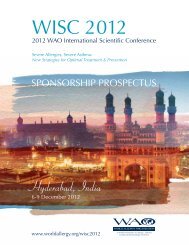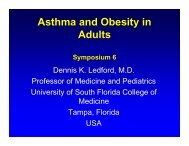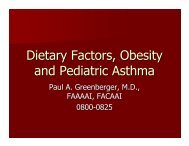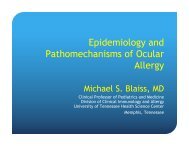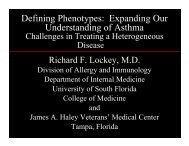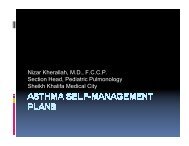Dubai Final-v20.indd - World Allergy Organization
Dubai Final-v20.indd - World Allergy Organization
Dubai Final-v20.indd - World Allergy Organization
You also want an ePaper? Increase the reach of your titles
YUMPU automatically turns print PDFs into web optimized ePapers that Google loves.
ABstrACts<br />
and dry weather city of Andhra Pradesh state in india, and the number of allergic population has been determined basing on the<br />
appearance of allergic symptoms, and measuring the absolute esinophil count, peak expiratory flow rate and estimation of igE<br />
antibody.<br />
results: Visakhapatnam city with ~70% humidity is found to trigger about 30% migrants to develop allergic symptoms to that of<br />
Anantapur city with ~40% humidity to 10% migrants to be allergic. Physical forces/non-immunogenic agents like rainy season,<br />
onslaught of monsoon, dampness, odors, exposure to sun light at certain angles or direct exposure to air conditioned breeze could<br />
trigger the spontaneous allergic rhinitis/asthma. Furthermore, a small variation in humidity from room to room in the same building<br />
can trigger allergic reactions in susceptible individuals. these allergic symptoms can be prevented by regulating the fan speed, or<br />
air-conditioned breeze. And also, it is observed that allergic symptoms appear more frequently in indoors rather than in outdoors,<br />
this is due to humidity, soiled robes, the other agents like house dust mite, unhygienic conditions or combination of other facts.<br />
Conclusion: there are certain kinds of physical agents which can induce allergic symptoms and also certain perfumes can relieve<br />
off existing asthmatic symptoms.<br />
3110<br />
THE STaTiSTiCS TaKE iT all: ComParaTiVE analYSiS oF THE gEnomiC BaCKgroUnD oF CHilDHooD aSTHma in<br />
CaUCaSian PoPUlaTion<br />
Hadadi, E. 1 , Ungvari, i. 1 , Virag, V. 1 , nemeth, Z. 2 , Hullam, g. 3 , Antal, P. 3 , Falus, A. 1 and szalai, C. 1<br />
1 2 3 genetics, Cell and immunbiology, semmelweis University, Budapest, Hungary. Csertex Kft, Budapest, Hungary. Department of<br />
measurement and information systems, Budapest University of technology and Economics, Budapest, Hungary.<br />
Asthma is a complex pulmonary disease with genetic and environmental components.<br />
Our purpose with this work was to identify new genes and snPs implicated in pathomechanism of asthma.<br />
in this study we selected candidate genes described in the literature and from our previously completed whole genome gene<br />
expression microarray analysis of OVA induced mouse model of asthma. For further analysis we selected 308 genes. For the<br />
selection of snPs, we created a new web-based data-mining and data-analyzing platform with the integration of public datastores.<br />
the program performs model-based analysis on results of text and data mining processes, previous measurements and<br />
Bayesian statistical analyses. Out of the 2643 snPs in these genes 399 snPs were chosen and used for panel design. We designed<br />
four 48plex panels with Autoprimer software and the determination of snPs was carried out with single base extension assays<br />
(genomelab snPstream, Beckman Coulter).<br />
genotyping was performed in 349 asthmatic children and 461 controls. statistical analysis was carried out by conventional<br />
frequentist analysis (chi-square test and logistic regression) and a new method developed by our team for the Bayesian analysis<br />
of relevant variables based on Bayesian model averaging (using markov Chain monte Carlo methods) and complex properties of<br />
Bayesian networks such as markov Blanket sets and markov Blanket graphs. the developed methodology of “Bayesian, four-level,<br />
sequential analysis of relevance” is capable of incorporating diverse priors to facilitate knowledge-rich data analysis, effecting more<br />
reliable results on multidimensional genomic studies.<br />
According to conventional analyses (logistic regression and c2 test) 36 snPs appeared to be associated with asthma in Hungarian<br />
population while by Bayesian multilevel analysis (BmlA) only 16 snPs came to the front and from these 8 showed association<br />
with asthma. According to our understanding a multifactorial genetic background can be revealed only by complex and aggregate<br />
method which can filter out essential and cardinal elements and alleviate the ‘noise’ /statistical faults. in our further studies we<br />
would like to test and confirm this conception.<br />
3111<br />
PrEValanCE oF HUman-mETaPnUEmoVirUS inFECTion in WHEEZY aDmiTTED CHilDrEn<br />
Alyasin, Jr., s. 1 and moatari, A. 2<br />
1 2 Pediatric, shiraz University of medical science, shiraz, iran. influenza research Center, shiraz University of medical science,<br />
shiraz, iran.<br />
introduction: Viral infections such as para- influenza, influenza and respiratory syncitial virus (rsV) contribute to the most of<br />
respiratory infections in children less than 5 year-old, yet causes for some 15-35% of children respiratory infections remained to be<br />
unknown. in recent years newly discovered human-metapnuemovirus (hmPV) showed to be one of the major causes for upper as<br />
well as lower respiratory tract infections especially in children. this virus also showed to be one of contributors in infants asthma<br />
exacerbation.<br />
method: in the present study, in one year, we examined 120 nasopharyngeal swaps from hospitalized children affected by<br />
wheezing for the presence of hmPV by rt-PCr technique. the datas are recorded in questionnaires.<br />
result: mean age for admitted children was 16 month-old .twenty out of 120 (16.6%) of<br />
www.worldallergy.org 143<br />
FinAl PrOgrAm<br />
ABstrACts



